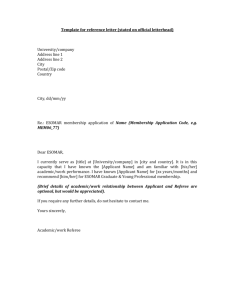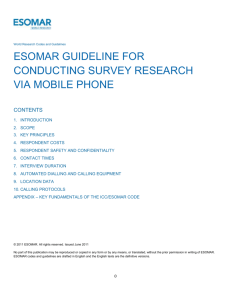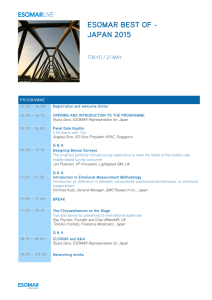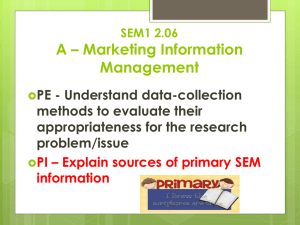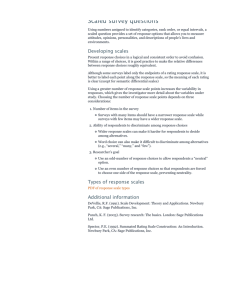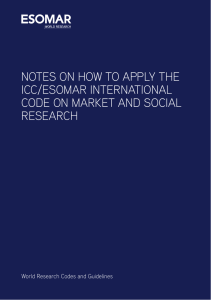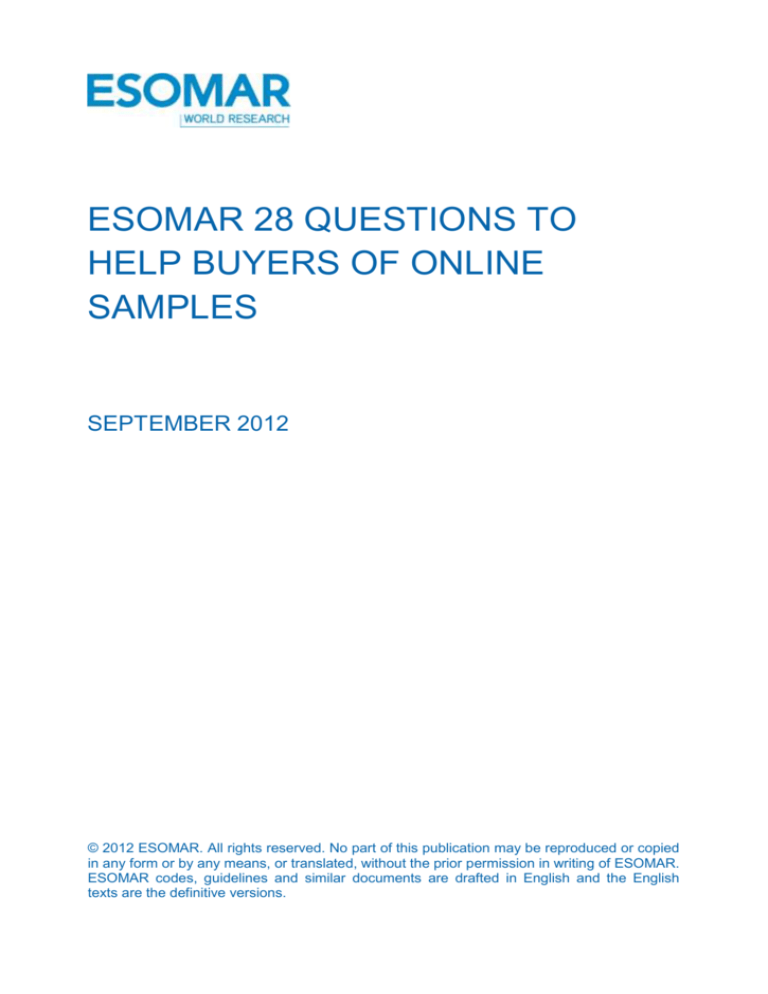
ESOMAR 28 QUESTIONS TO
HELP BUYERS OF ONLINE
SAMPLES
SEPTEMBER 2012
© 2012 ESOMAR. All rights reserved. No part of this publication may be reproduced or copied
in any form or by any means, or translated, without the prior permission in writing of ESOMAR.
ESOMAR codes, guidelines and similar documents are drafted in English and the English
texts are the definitive versions.
ESOMAR 28 QUESTIONS TO HELP
RESEARCH BUYERS OF ONLINE
SAMPLES
September 2012
INTRODUCTION
The primary aim of these 28 Questions is to increase transparency and raise awareness of the key
issues for researchers to consider when deciding whether an online sampling approach is fit for their
purpose. Put another way, the aim is to help researchers to ensure that what they receive meets their
expectations. The questions are also designed to introduce consistent terminology for providers to
state how they maintain quality, to enable buyers to compare the services of different sample suppliers.
Notes on the context of the questions explain why the questions should be asked and which issues
researchers should expect to be covered in the answer.
These new questions replace ESOMAR’s “26 Questions to help Research Buyers of Online Samples”.
ESOMAR has updated the text to recognize the ongoing development of techniques. While some of
the questions remain constant, new questions have been added to incorporate new techniques and
new technology in this area. In particular, this revision recognises the broad trend within the industry to
build online samples from multiple sources rather than relying on a single panel.
It should be noted that these 28 Questions focus on the questions that need to be asked by those
buying online samples. If the sample provider is also hosting the data collection you will need to ask
additional questions to ensure that your project is carried out in a way that satisfies your quality
requirements.
The 28 Questions complement ESOMAR’s Guideline to Online Research which was revised in 2011 to
add updated legal and ethical guidance and new sections on privacy notices, cookies, downloadable
technology and interactive mobile.
COMPANY PROFILE
1. What experience does your company have in providing online samples for market research?
Context: This answer might help you to form an opinion about the relevant experience of the sample
provider. How long has the sample provider been providing this service and do they have for example
a market research, direct marketing or more technological background? Are the samples solely
provided for third party research, or does the company also conduct proprietary work using their panels?
SAMPLE SOURCES AND RECRUITMENT
2.
Please describe and explain the type(s) of online sample sources from which you get
respondents. Are these databases? Actively managed research panels? Direct marketing
lists? Social networks? Web intercept (also known as river) samples?
Context: The description of the types of sources a provider uses for delivering an online sample will
provide insight into the quality of the sample.
3.
If you provide samples from more than one source: How are the different sample sources
blended together to ensure validity? How can this be replicated over time to provide
reliability? How do you deal with the possibility of duplication of respondents across
sources?
Context: The variation in data coming from different sources has been well documented. Overlap
between different panel providers can be significant in some cases and de-duplication removes this
source of error, and frustration for respondents.
2
4.
Are your sample source(s) used solely for market research? If not, what other purposes are
they used for?
Context: Combining respondents from sources set up primarily for different purposes (like direct
marketing for example) may cause undesirable survey effects.
5. How do you source groups that may be hard to reach on the internet?
Context: Ensuring the inclusion of hard-to-reach groups on the internet (like ethnic minority groups,
young people, seniors etc.) may increase population coverage and improve the quality of the sample
provided.
6.
If, on a particular project, you need to supplement your sample(s) with sample(s) from other
providers, how do you select those partners? Is it your policy to notify a client in advance
when using a third party provider?
Context: Many providers work with third parties. This means that the quality of the sample is also
dependent on the quality of sample providers that the buyer did not select. Transparency is essential in
this situation. Overlap between different providers can be significant in some cases and de-duplication
removes this source of error, and frustration for respondents. Providers who observe process
standards like the ISO standards are required to give you this information.
SAMPLING AND PROJECT MANAGEMENT
7. What steps do you take to achieve a representative sample of the target population?
Context: The sampling processes (i.e. how individuals are selected or allocated from the sample
sources) used are the main factor in sample provision. A systematic approach based on market
research fundamentals may increase sample quality.
8. Do you employ a survey router?
Context: A survey router is a software system that allocates willing respondents to surveys for which
they are likely to qualify. Respondents will have been directed to the router for different reasons,
perhaps after not qualifying for another survey in which they had been directly invited to participate, or
maybe as a result of a general invitation from the router itself. There is no consensus at present about
whether and how the use of a router affects the responses that individuals give to survey questions.
9.
If you use a router: Please describe the allocation process within your router. How do you
decide which surveys might be considered for a respondent? On what priority basis are
respondents allocated to surveys?
Context: Biases of varying severity may arise from the prioritisation in choices of surveys to present to
respondents and the method of allocation.
10. If you use a router: What measures do you take to guard against, or mitigate, any bias
arising from employing a router? How do you measure and report any bias?
Context: If Person A is allocated to Survey X on the basis of some characteristic then they may not be
allowed to also do Survey Y. The sample for Survey Y is potentially biased by the absence of people
like Person A.
11. If you use a router: Who in your company sets the parameters of the router? Is it a
dedicated team or individual project managers?
Context: It may be necessary to try to replicate your project in the future with as many of the
parameters as possible set to the same values. How difficult or easy will this be?
12. What profiling data is held on respondents? How is it done? How does this differ across
sample sources? How is it kept up-to-date? If no relevant profiling data is held, how are low
incidence projects dealt with?
3
Context: The usefulness to your project of pre-profiled information will depend on the precise question
asked and may also depend on when it was asked. If real time profiling is used, what control do you
have over what question is actually asked?
13. Please describe your survey invitation process. What is the proposition that people are
offered to take part in individual surveys? What information about the project itself is given
in the process? Apart from direct invitations to specific surveys (or to a router), what other
means of invitation to surveys are respondents exposed to? You should note that not all
invitations to participate take the form of emails.
Context: The type of proposition (and associated rewards) could influence the type of people who
agree to take part in specific projects and can therefore influence sample quality. The level of detail
given about the project may also influence response.
14. Please describe the incentives that respondents are offered for taking part in your surveys.
How does this differ by sample source, by interview length, by respondent characteristics?
Context: The reward or incentive system may impact on the reasons why people participate in a
specific project and these effects can cause bias to the sample.
15. What information about a project do you need in order to give an accurate estimate of
feasibility using your own resources?
Context: The “size” of any panel or source may not necessarily be an accurate indicator that your
specific project can be completed or completed within your desired time frame.
16. Do you measure respondent satisfaction? Is this information made available to clients?
Context: Respondent satisfaction may be an indicator of willingness to take future surveys.
Respondent reactions to your survey from self-reported feedback or from an analysis of suspend
points might be very valuable to help understand survey results.
17. What information do you provide to debrief your client after the project has finished?
Context: One should expect a full sample provider debrief report, including gross sample, start rate,
participation rate, drop-out rate, the invitation/contact text, a description of the field work process, and
so on. Sample providers should be able to list the standard reports and metrics that they make
available.
DATA QUALITY AND VALIDATION
18. Who is responsible for data quality checks? If it is you, do you have in place procedures to
reduce or eliminate undesired within survey behaviours, such as (a) random responding, (b)
Illogical or inconsistent responding, (c) overuse of item non-response (e.g. “Don’t Know”)
or (d) speeding (too rapid survey completion)? Please describe these procedures.
Context: The use of such procedures may increase the reliability and validity of the survey data.
19. How often can the same individual be contacted to take part in a survey within a specified
period whether they respond to the contact or not? How does this vary across your sample
sources?
Context: Over solicitation may have an impact on respondent engagement or on self-selection and
non-response bias.
20. How often can the same individual take part in a survey within a specified period? How
does this vary across your sample sources? How do you manage this within categories
and/or time periods?
Context: Frequency of survey participation may increase the risk of undesirable conditioning effects or
other potential biases.
4
21. Do you maintain individual level data such as recent participation history, date of entry,
source, etc., on your survey respondents? Are you able to supply your client with a project
analysis of such individual level data?
Context: This type of data per respondent including how the total population is defined and how the
sample was selected and drawn, may increase the possibilities for analysis of data quality.
22. Do you have a confirmation of respondent identity procedure? Do you have procedures to
detect fraudulent respondents? Please describe these procedures as they are implemented
at sample source registration and/or at the point of entry to a survey or router. If you offer
B2B samples what are the procedures there, if any?
Context: Confirmation of identity can increase quality by decreasing multiple entries, fraudulent
panellists etc.
POLICIES AND COMPLIANCE
23. Please describe the ‘opt-in for market research’ processes for all your online sample
sources.
Context: The opt-in process indicates the respondents’ relationship with the sample source provider.
The market generally makes a distinction between single and double opt-in. Double opt-in refers to the
process by which a check is made to confirm that the person joining a panel or database wishes to be a
member and understands what to expect (in advance of participating in an actual survey for a paying
client).
24. Please provide a link to your Privacy Policy. How is your Privacy Policy provided to your
respondents?
Context: Not complying with local and international privacy laws might mean the sample provider is
operating illegally. An example privacy policy is given in the ESOMAR Guideline for Online Research.
25. Please describe the measures you take to ensure data protection and data security.
Context: The sample provider usually stores sensitive and confidential information on panellists and
clients in databases. These data need to be properly secured and backed-up, as does any confidential
information provided by the client. The sample provider should be able to provide you with the latest
date at which their security has been evaluated by a credible third-party
26. What practices do you follow to decide whether online research should be used to present
commercially sensitive client data or materials to survey respondents?
Context: There are no foolproof methods for protecting audio, video, still images or concept
descriptions in online surveys. In today’s social media world, clients should be aware that the
combination of technology solutions and respondent confidentiality agreements are “speed bumps” that
mitigate but cannot guarantee that a client’s stimuli will not be shared or described in social media.
27. Are you certified to any specific quality system? If so, which one(s)?
Context: Being certified may require the supplier to perform tasks in a pre-determined manner and
document procedures that should be followed.
28. Do you conduct online surveys with children and young people? If so, do you adhere to the
standards that ESOMAR provides? What other rules or standards, for example COPPA in
the United States, do you comply with?
Context: The ICC/ESOMAR International Code requires special permissions for interviewing children.
These are described in the ESOMAR Online Research Guideline. In the USA researchers must adhere
to the requirements of the Children’s Online Privacy Act (COPPA). Further information on legislation
and codes of practice can be found in Section 6 of ESOMAR’s Guideline for Online Research.
5
GUIDANCE ON PROFESSIONAL STANDARDS
Maintaining consumer trust is integral to effective market, social and opinion research. ESOMAR
through its codes and guidelines promotes the highest ethical and professional standards for
researchers around the world.
The ICC/ESOMAR Code on Market and Social Research, which was developed jointly with the
International Chamber of Commerce, sets out global fundamentals for self-regulation for researchers. It
has been undersigned by all ESOMAR members and adopted or endorsed by more than 60 national
market research associations worldwide.
The ESOMAR Guideline on Guideline on Online Research is of particular relevance to researchers
using online panels and should be read in conjunction with these questions for more explanation of the
legal and professional responsibilities of researchers who are collecting and analysing online research
data.
In addition, ESOMAR has issued the following guidelines to provide more detailed advice on how to
address the legal, ethical, and practical considerations of conducting specific areas of research:
Guideline on Social media research
Guideline for Conducting mobile research
Guideline on Online research
Guideline on Distinguishing market research from other data collection activities
Guideline on Passive data collection, observation and recording
Guideline on Interviewing children and young people
Guideline on Customer satisfaction studies
Guideline on Mystery shopping
Guideline on How to commission research
ESOMAR/WAPOR Guide to opinion polls
There are also two ISO standards which relate to market research:
ISO Standard 26362 – Access panels in market, opinion and social research - Vocabulary and service
requirements
ISO 20252 - Market, opinion and social research - Vocabulary and service requirements
These documents contain useful definitions and explain process quality standards for access panels
and research projects. They explain good practice and the information that should be provided to clients.
They can be purchased from the International Standards Organisation http://www.iso.org/iso/home.html
ESOMAR – World Association for Social, Opinion and Market Research
Eurocenter 2,11th Floor
Barbara Strozzilaan 384
1083 HN Amsterdam
The Netherlands
Tel: +31 20 664 2141
www.esomar.org
For more information contact professional.standards@esomar.org
PROJECT TEAM
Adam Phillips, Chair of ESOMAR’s Legal and Professional Standards Committees
Pete Cape, Global Knowledge Director, SSI and Editor of the text
Reg Baker, COO, Market Strategies International,
Mike Cooke, Director, Global Panel Management, GfK
Efrain Ribeiro, COO, Lightspeed Research
George Terhanian, Chief Strategy and Product Officer, Toluna USA
6

